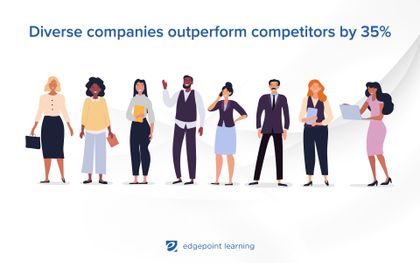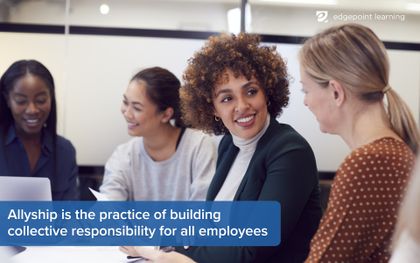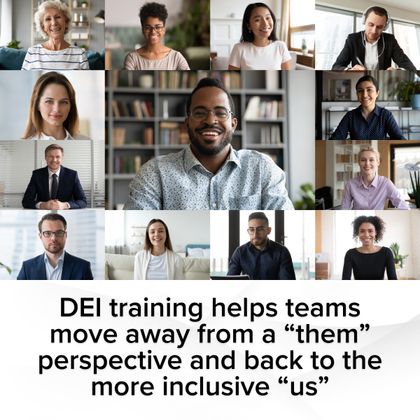How To Build A Diversity, Equity, And Inclusion Training Program
Corey Bleich
🍿 5 min. read
More than just teaching tolerance, DEI training helps to build a workplace that is safe, supportive, and truly inclusive
As workplaces become global and movements for racial and social justice build momentum, it’s time to take a hard look at your diversity, equity, and inclusion training. More than just teaching tolerance, DEI training helps to build a workplace that is safe, supportive, and truly inclusive for everyone in the building (or at home!). Here’s your guide to making that happen.
What is diversity, equity, and inclusion training for employees?
If we think of diversity, equity, and inclusion training as an iceberg, the superficial metrics just aren’t enough. Yes, it’s absolutely crucial to make sure that actions of discrimination (hate speech, discriminatory policies regarding dress, etc.) are not present, but it goes much deeper than that.
Diversity, equity, and inclusion training for employees addresses big issues, including:
- Ensuring everyone has equal access to resources and support
- Creating systemic structures that acknowledge and honor cultural differences
- Building a company culture from the inside out
- Developing a company mission that models inclusive practices
- Finding, addressing and rectifying historical bias within your company
It’s not enough to tick the box indicating which traditionally marginalized or historically underrepresented groups you’ve employed. DEI training goes deep to change the culture of a workplace itself.
Equity is more than just a seat at the table – it’s putting all the utensils in place for everyone to dine well.
Why is it important?
Employees are continuing to call for more respect and inclusion in the workplace. An estimated 48% of employees believe that respect is crucial in the workplace, but more than half of them don’t feel respected by their bosses.
And there’s more.
- Millennials will make up 75% of the workforce by 2025, and almost 45% of them consider themselves “non-white”
- A 2020 report found that 9.1% of Millennials, and 15.9% of Gen Z, identify as LGBTQ
- Formerly “minority” groups will reach “majority” status by 2044
- There will be no single ethnic majority/minority by 2065
Our workplaces are becoming more diverse whether we acknowledge it or not. But the benefits of this inclusion – and the DEI training it requires – are incredible.
- Diverse companies make more money: In 2015, McKinsey posted a report connecting diversity and financial performance – this research has held up over time
- Diverse companies are more innovative: Cognitive diversity in particular increases innovation by 20%
- Diverse companies perform better: Diverse companies outperform their competitors by 35%
- Team work makes the dream work: Diverse teams are better at making decisions – 87% better – than individuals

DEI training topics to cover
Each company will tailor their diversity, equity, and inclusion training to their needs, but most will include these five broad categories.
1. Diversity vs. inclusion
Diversity – representation of groups in the workplace – is the first step, but it’s just the first step. Inclusion means those groups are involved in decision making at the organizational level.
They are given a voice at the table, resources, and encouragement to make changes that foster equity across all characteristics, backgrounds, abilities, experiences, and perspectives.
2. Unconscious bias
Unconscious bias (also referred to as implicit bias) is a product of growing up in a culture. It is an inescapable feature of every person walking the earth.
If a culture has a history of systemic and institutionalized discrimination, even the most aware and conscious person still carries with them these unconscious thoughts. DEI training makes participants aware of their biases and helps them to address them.
3. Microaggressions
Microaggressions are often another product of unconscious bias. These “deaths by a thousand cuts” include things like:
- Interrupting women or nonbinary people in meetings
- Noting that a Black person is “articulate”
- Assuming sexual orientation or pronouns from appearance
Recognizing what microaggressions are and retraining employees is a crucial part of fostering an inclusive community through DEI training.
4. Building allyship
Diversity, equity, and inclusion training programs help employees become aware of how they can be allies of traditionally marginalized or historically underrepresented groups, in and out of the workplace.

Allyship is the practice of building collective responsibility for all employees and how they are treated. It leads naturally into the final part of DEI training.
5. Bystander intervention training
Many people are uncomfortable when they see discrimination occurring but don’t know how to act. They may fear for their own safety or worry about elevating the conflict.
Bystander intervention training gives employees the tools they need to safely intervene, so they can help de-escalate conflict and work towards a resolution.
Diversity, equity, and inclusion training ideas
When you begin to diversify your training, it can be challenging to know which tools to reach for. Which methods help identify the types of diversity training that you need, and how will you effectively implement DEI training? Can you start this development by bringing in a variety of voices to amplify what is most important? Chances are good that historically underrepresented employees will have more insight into their own needs.
As with most training programs, the first step is to identify what is needed and to tailor diversity, equity, and inclusion training ideas to meet those needs.
You might use microlearning or eLearning tools for background materials, but it’s also crucial to incorporate interactive training methods (e.g., simulation training and group discussions). Personal interactions are necessary to bring teams closer, away from a “them” perspective and back to the more inclusive “us.”

The topics covered in DEI training are intensely personal for all participants. Employees who face routine discrimination are understandably angry, and employees who do not might feel accused or defensive. It’s important to set up a structure that accommodates these heightened emotions and allows ample time to process complicated feelings.
If this sounds more “touchy-feely” than other employee trainings – it is. Diversity, equity, and inclusion training confronts generational bias and is likely to bring up many feelings, more than if you were simply offering a training on safe lifting. Make sure your trainers have also developed the skills to honor and respect whatever arises to help employees work towards more equity.
Build a more equitable workplace
Let’s be clear: diversity, equity, and inclusion training won’t end larger societal issues with systematic racism and injustice, but some progress starts with you and your teams. DEI training is one step that your company can take to be the change you want to see in the world.
If you don’t know where to start, have questions about diversity, equity, and inclusion training, or need feedback on what you have so far, EdgePoint Learning can help.
Get in touch to start building a more equitable workplace today.
